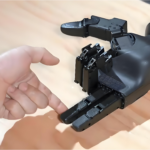March 20-23, Shanghai – Humanoid robots have been a market sensation this year, and AWE 2025 is no exception.
“I’m Xiaomai, a humanoid robot from Magic Atom. Today, I was invited by Dreame Technology to witness this historic moment… As the creativity of carbon-based life forms dances with the intelligence of silicon-based beings, a world of infinite possibilities unfolds before us.” These words marked the opening of Dreame Technology’s “Born Without Boundaries” 2025 Ecosystem Launch Event in Shanghai, held a day before AWE officially began. Xiaomai, a humanoid robot from Magic Atom, was invited as the host, marking the world’s first major tech conference hosted by a humanoid robot. Xiaomai interacted fluidly with the audience, demonstrating precise synchronization of speech, tone, and body movements, showcasing the deep integration of robotic motion control systems.
AWE 2025: A Showcase for Cutting-Edge Robots
Xiaomai set the stage for an impressive lineup of robotic innovations at AWE 2025. Following its viral appearance at the 2025 CCTV Spring Festival Gala, where it performed a traditional Chinese dance, Unitree Robotics has continued to capture attention. At AWE, Unitree showcased its humanoid robot G1 and robotic dog Go2, drawing large crowds eager to interact with them. The company’s booth was surrounded by enthusiastic visitors, with robots patrolling and waving to spectators. Promotional materials displayed the Go2 robotic dog’s price at ¥9,997 ($1,380), while the G1 humanoid robot is listed at ¥99,000 ($13,700) on JD.com.
Unitree Robotics Showcases Humanoid and Quadruped Robots
TRON 1, a bipedal robot from LimX Dynamics, made an appearance at the Pacific Network booth. TRON 1 is the industry’s first “three-in-one” modular legged robot, capable of transitioning between three modes: point-foot, bipedal, and dual-wheeled locomotion, adapting seamlessly to various scenarios. The robot demonstrated a range of movements and even resisted external force pushing, highlighting its impressive stability and flexibility.
Beyond dedicated robotics companies, several traditional home appliance brands also introduced their robotic innovations.
AI Companion Robots and Smart Home Assistants
- Humanoid robots debuted the Ai Me, the world’s first modular AI companion robot, making its first public appearance at a Chinese exhibition. The Ai Me robot integrates bionic design and advanced AI, enabling multi-modal natural interactions, emotional companionship, and intelligent home monitoring through auto-tracking and capturing memorable moments.
- JD.com showcased a humanoid robot leading a squad of five robotic dogs, co-developed with Weilan Technology. These robots function as mobile voice assistants.
Household Service Robots: Merging AI and Functionality
Beyond humanoid and quadrupedal robots, home service robots remained a key focus at AWE 2025:
- Roborock unveiled the G30 Space Explorer Edition, a self-cleaning sweeping and mopping robot. It features an industry-first 5-axis folding bionic robotic arm, Star Matrix 3.0 navigation system, and 7.98cm ultra-thin body. The robotic arm can grasp objects weighing up to 1kg and uses 3D ToF sensors for spatial obstacle avoidance and object repositioning. A company representative emphasized that “developing a robotic arm is easy, but integrating it into a compact device while ensuring smooth operation is the real challenge.”
- Narwal introduced its latest AI-powered track-based mopping robot, Xiaoyao 002.
- Dreame showcased its first-ever intelligent window-cleaning robot, the C1 series.
The Future of Humanoid Robots in Smart Homes
According to Sihan Industry Research Institute, humanoid robots are becoming a pivotal form of smart home robots due to their ability to mimic human behavior and interactions. Their human-like design fosters emotional connections and enhances their ability to perform complex tasks, particularly in home companionship, healthcare, and education assistance.
The institute projects that China’s humanoid robot industry will enter early-stage mass production in 2025, with an estimated annual output of 200,000 to 300,000 units. From 2025 to 2029, the household intelligent robot market is expected to expand from $2.06 billion to $8.86 billion, achieving a 44% compound annual growth rate (CAGR).
AWE 2025 has demonstrated that AI-powered humanoid robots are no longer just a concept but a growing reality, poised to redefine the future of home robotics.




